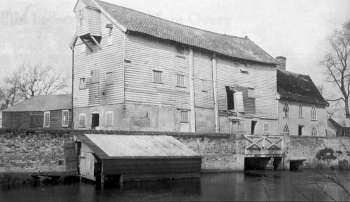 |
|
c.1900
|
|
Ellingham Mill
River Waveney |
 |
|
c.1900
|
|
Ellingham watermill
was built of white weatherboard over a brick base with a pantiled roof.
As can be seen from the photographs below, it changed dramatically over
the years as it was enlarged and developed. Along with Ditchingham and Earsham,
it was one of the only three Norfolk watermills on the Waveney. |
Ellingham and Earsham are the only two mills on the Waveney that are officially in Norfolk. |
|
The last waterwheel to be fitted was 17h.p. and made of iron. John Munnings (1916-1987), grandson of the artist Alfred Munnings and great grandson John Munnings, miller of Mendham Mill related that the wheel was supplemented by a 8-10h.p. German turbine c.1895 and the wheel was then eventually removed and replaced by a much larger Armfield 90h.p. turbine. (This possibly happened around 1908 after the Walker brothers had taken over). John Munnings also mentioned that apparently the Armfield turbine proved to be too large for the river and could only be used to full capacity when the river had a good head of water and the tail water in the millpool was low. However, he was complimentary of the mill stating that it was Once one of the most up-to-date mills on the River until flour milling ceased (in 1949) and that it was one of the few country mills using plansifters instead of centrifugals - i.e. flour sieves as opposed to flour dressers. |
|
The first known reference to the mill was c.1200 in an agreement between Alexander de Kerkeby and William de Hales that Alexander should pledge to William his part of the mill along with easements in water and fishing rights in return for 80 marks of silver. |
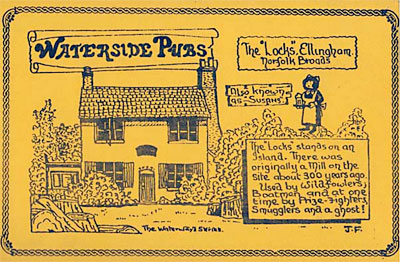 |
|
Postcard c.1945 |
|
Ellingham had an early watermill that was probably working in at least the 1500s and 1600s. It is probable that the mill was built over the original river course on land that later became an island. A new cut was eventually made to straighten the river and bypass the mill. The Locks Inn now stands adjacent to the mill's original; postion. |
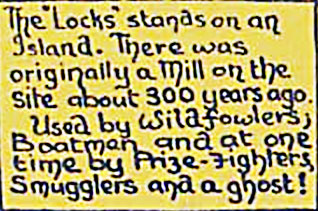 |
|
Legend from the postcard above |
|
On 7th September 1672, an indenture assessing the Lockage on the Bungay Navigation cites the mill in an order from the Commissioners where it appears there is a difference between the Exors. And the Heirs-in-law of Mr. Hammond late of Ellingham in the Co. of Norfolk as to which of them the estate in a Water Mill in Ellingham aforesaid should belong. Dat 1676. |
|
On 1st January
1772, Lincoln Matchett, the miller took out insurance on the mill: |
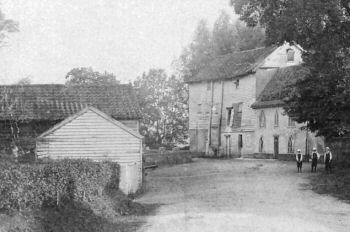 |
|
Three schoolgirls pose outside the mill c.1910
|
|
During the American War of Independence 1775-1783 Bungay, Ellingham and Wainford mills produced flour for export to America. |
|
In 1788, the mill owner Michael Hicks was mentioned in connection with an Arbitration with the occupier of the mill and Matthias Kerrison who owned the Navigation. |
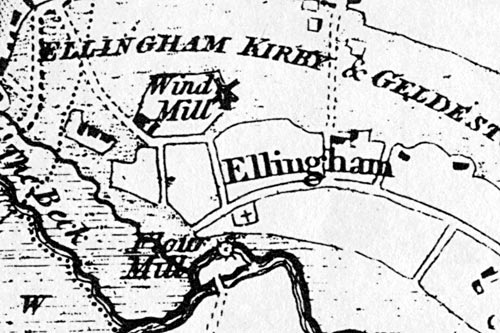 |
Faden's map 1797 |
|
When James Holden died in early 1809 the mill was advertised To be let for 9 years. The advert also stated that the mill drives four pairs of stones and that enquiries should be made of Sawer & Williams, Cornfactors, Coopers Row, London |
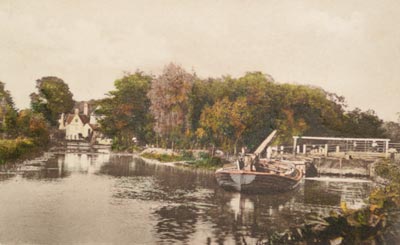 |
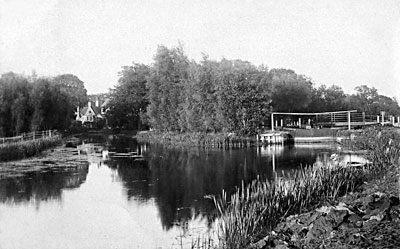 |
|
A wherry and the lock with the mill in the distance c.1910
|
Mill and lock c.1912 |
|
Robert Burtsal
jnr (1803-1856) was miller from at least 1836 until
he died in April 1856. Robert Burtsal jnr was the son of Robert Burtsal
snr from whom he probably learnt his milling trade, as Robert snr was
the miller at Bungay towermill. Robert jnr was married to Elizabeth Virtue
Browne daughter of a Lowestoft fish merchant and grand-daughter of Robert
Browne, who was manager and part owner of the Lowestoft porcelain factory.
|
|
William Shearing jnr took over as miller after Robert Burtsal died. His mother Ann Elizabeth Chaston, was another granddaughter of Robert Browne and she was married to William Shearing snr, a farmer in St Cross, South Elmham on the other side of Bungay, William Shearing jnr was probably their eldest son. He was certainly married in Ellingham in 1862 but had moved to Blundeston by 1870, where he was a corn merchant. |
|
Walter Thurtell, miller at Wighton watermill was a cousin of the Brownes of the Lowestoft porcelain factory (his mother was a Browne) and there were a number of millers in various parts of East Anglia called Chaston who were also their cousins of the Brownes. |
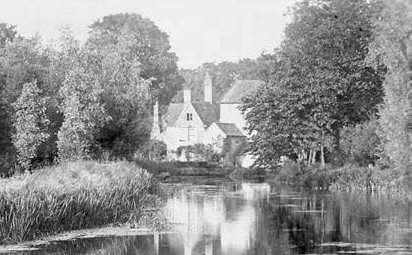 |
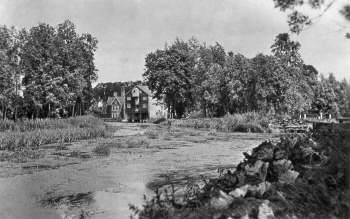 |
|
Ellingham dam c.1900
|
Ellingham
dam c.1910 |
My great grandfather and great grandmother both drowned at Ellingham Mill during the 1890's. It was believed to be accidental although it would appear on reading the paperwork it was a suicide and accident/murder. Their names were Samuel and Jane Harley.
Brenda Eardley - 18th March 2007 |
MYSTERIOUS TRAGEDY |
On Saturday morning at ten o'clock one of the millers employed at Ellingham watermill made a horrible discovery. Observing something in a dyke leading into the river Waveney in the two mile he made investigations and found the bodies of a man and woman in the water. Both were quite dead, and he obtained assistance and conveyed the bodies to Mettingham Tally Ho. Inquiries revealed the identities of the deceased as Mr and Mrs Harlev of Beccles, the man having been lately employed at the Tan Yard. It is said that he had a short time since attempted to commit suicide. During the last few days he and his wife had been staying with his daughter at Shipmeadow. The deceased were ending their visit on Saturday, intending to take the train at Ellingham Station, and it is conjectured that on the way Harley jumped into the dyke. It is thought that his wife went to the rescue and that a struggle ensued ending fatally for both. A cut or bruise is visible on the womans temple. The whole affair must have happened very quickly as some persons went past the spot only a short time previously, and nothing was seen of the deceased who left their daughters home at just before nine. On Saturday evening Mr Coroner Chaston opened the inquest upon the bodies at Mettingham Tally Ho, Mr E. Brock being foreman of the jury. The first witness called was Mrs Mary Mayes, a labourers wife, residing in Shipmeadow, who identified the bodies as those of Samuel Harley aged 49 late a workman at the Tannery in Beccles, and Jane Harley, his wife aged 48. Harley had been staying with his daughter Mrs Robert Mayes, of Shipmeadow since Monday. Mr. A. Sheldon, lucum tenens, to Dr. Betenson of Bungay was the next witness. He said that he had made an examination of the bodies and attributed the death of both to suffocation by drowning. The womans left eye was swollen and black and there was an abrasion on the left eyebrow, probably caused before death. Owing to short notice all the witnesses were not present and the Coroner adjourned the court until Saturday next. An order for burial was given. |
The adjourned inquest took place on the bodies of Mr. and Mrs. Harley who were found in a dyke at Mettingham, near Bungay. The general opinion is that the man committed suicide and that the woman was accidentally drowned while trying to save him. A verdict was returned accordingly. Eastern Daily Press - Monday 11th September 1899 |
|
On Friday 14th
June 1907, George Durrant & Sons offered the mill complex for sale
by auction at the Kings Head Hotel, Beccles on the instructions of the
Personal Representative of the late Henry Youngman |
|
It was reported in The Miller on 1st July 1907 that the mill was withdrawn from the sale. This was possibly because the property had not reached its reserve. However, it was later bought by Colonel Smith of Ellingham Hall. In September 1908 one of Colonel Smith's tenants George Butler, the miller, was found hanging at the mill. The subsequent inquest found that business worries had brought about a state of depression during which, he had taken his own life and a verdict of temporary insanity was recorded. |
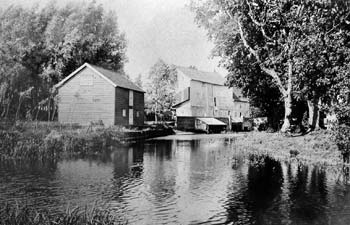 |
|
c.1920
|
|
William David Walker bought the mill from Colonel Smith in 1908 and he soon went into partnership with his brother Arthur Ernest Walker trading as W.D. & A.E. Walker Ltd., Ellingham Patent Roller Mills. The company proved successful and ended up outliving its founders, eventually being sold to Hovis Ltd. in 1947. |
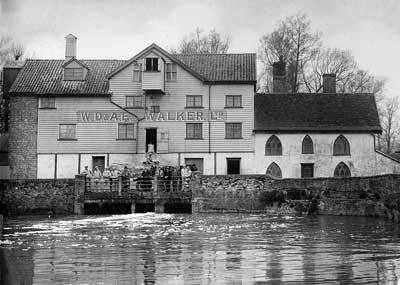 |
|
c.1935
|
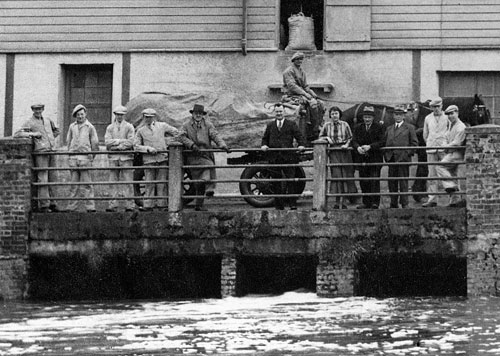 |
|
Closeup of 1935 mill staff from the photo above
|
Left to right: Fred Burroughs jnr.; Eric Gilbert; Sid Hood; Donny Tilney; Major Ellis (nephew of Mr. Walker); Hubert Stone (manager); Mary Stone (daughter); Fred Burroughs snr. (foreman); Mr. Ernest Walker; Leslie Seaman; Horace Neil; Dot Hood (on cart); Joshua (horse) |
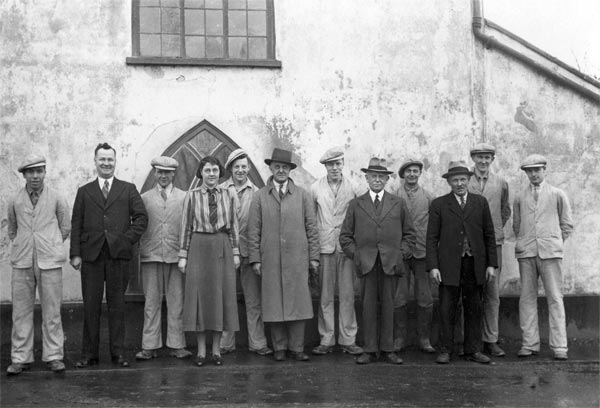 |
Mill staff in 1935 |
Left to right: Horace Neil, Mr Hubert Stone (my grandfather), Don Tilney, Mary Stone (my mother), Eric Gilbert, Major Ellis, Leslie Seaman, Mr Walker, Dot Hood, Mr Burroughs Snr, Mr Fred Burroughs (son) and Sidney Hood. |
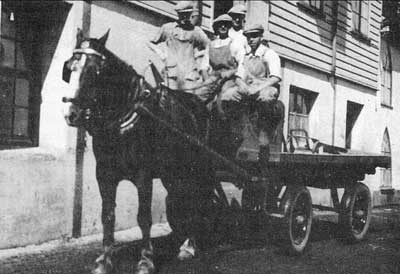 |
|
The mill cart c.1940
|
| Left to right: Joshua (horse); Leslie Seaman; Dot Hood; Sid Hood; Horace Neal. |
My grandfather, Mr. Hubert Stone, was manager of the mill, and my mother, Mary Stone, and Major Ellis worked for him as clerks. Dot Hood (real name Reuben Hood - dont know why the nickname) was lorry driver. Mr Burroughs Snr was foreman. As far as my mother can remember, the others are mill hands.
Mr Walker used to come in on a Thursday morning, but otherwise left the running to my grandfather. Mr Walker also had a maltings at the Staithe, in Bungay, and Stalham in Norfolk. The Bungay one was sold to Watneys, not sure about the Norfolk one. My grandfather worked originally in Bungay, but moved to Ellingham in the 1920s, and I think stayed there his whole working life. My mother worked there after leaving school in 1933. I remember as a child walking with my grandfather through the corn which seemed as tall as me (has wheat got smaller over the years?) in a farm adjoining Elingham Mill, also owned by Mr Walker, during my school holidays in August. He used to 'taste' the ears of corn, I realise now this was to check moisture content and decide when to harvest. My grandfather would have been over 65 then, so he may have either done this as a consultant part-time, or possibly continued working till 70. Tom Hood, a brother of Sid and Dot, worked on a nearby farm, possibly the same one. My mother has a painting of Elingham Mill done by a Helen Harbert in 1984.
David Livermore - 12th June 2006 |
|
Mrs. Leslie Seaman of Attleborough recalled that on occasions when
a new lot of wheat was ground, her mother Mrs. Fred Burrows, made and
baked a batch of white and brown bread for Mr. Ernest Walker to sample.
Mrs. Seaman went to the mill cottage in 1916 at the age of three when
her father, Mr. Fred Burrows, joined the mill staff. Her husband, Mr.
Leslie Seaman worked in the mill from 1930 at the age of 18, until he
was called up for War Service in 1941. Her brother Mr. Fred Burrows, Jnr.,
also worked at the mill. When Mr. Leslie Seaman started at the mill his
wages were 22s 6d per week and his work included carrying sacks of grain
up to the granary. |
Another employee at Ellingham Mill, Mr. Sidney Hood, retired in 1977
after 51 years service in the Agricultural Merchants Trade. He started his
working life with WD& AE Walker Limited, spending the first few months
on a farm at Ellingham, then he moved to Bungay Staithe where he helped
to look after pigs. At about the age of 18 he moved to Ellingham Mill from
where he delivered goods by horse and trolley for a year going seven or
eight miles on a journey. Later he also worked at Earsham
Mill and as a schoolboy well remembered the wherries on the Waveney,
indeed he helped to unload the last one to come up which, was the "Albion".
He also vividly remembers the floods at Ellingham and during the 1940's
he spent a whole night at the mill making sure it did not become flooded,
accompanied by a number of rats! On another occasion he ran a race with
a "mate" of his at Ellingham Mill, each carrying 17 stone of maize
on their backs over a distance of 100 yards! The River Waveney, it's Navigation and Watermills - Donald Pluck 1994 - see Special Thanks on Home |
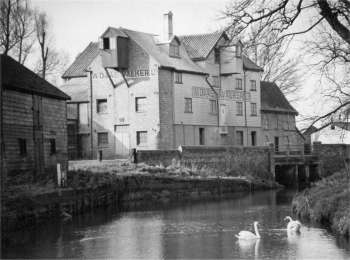 |
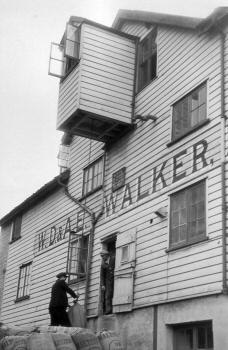 |
|
WD & AE Walker's mill in the 1950s
|
c.1950 |
|
By the time William David Walker bought Ellingham mill, he was already a well established business and civic figure in Bungay. He was born in Beccles in 1847 and after he married Sarah Elizabeth Hope (b.1873 in Manchester), they lived at Olland House (later Dunelm), Lower Olland Street, Bungay. After Sarah died in 1888, he married her sister Mabel and was the father of eight children from the two relationships. Besides being a staunch supporter of the Congregational Church, William Walker was Town Reeve for a total of five terms between 1888 and 1911 and also became a J.P. in 1907. |
|
Arthur Ernest Walker b.1852/3 was William's younger brother and he lived at Tower House, Brundall. He visited the mill once a week, usually on a Thursday morning, arriving in either a maroon or navy chauffeur driven car with the chauffeur's uniform matching the colour of the car. In 1935 the chauffeur was Major Ellis. Children were always banned from playing in front of the mill whenever Ernest Walker visited and if any child met Mr. Walker they had to curtsey. Arthur Ernest Walker eventually died at the age of 93. |
W. D. & A. E. Walker Ltd took over the navigation rights of the River Waveney c.1890,
owning and operating a fleet of wherries, many being built at their Bungay
Staithe boatyard by boatbuilders John Winter and George Davey.
The Walker brothers also owned Bungay Staithe Maltings, which also provided
considerable trade for the wherry fleet. Wherries owned by the company included
Hope, Mayflower, Eudora, Iolanthe and Albion
and all were painted bright green with yellow and blue banded mastheads. |
The wherry Albion
was built by William Brighton at Oulton Broad in 1898. Wherries were normally
clinker built but the company insisted that Albion
be built carvel planked. The reasoning behind this was that clinker planked
wherries invariably scraped the rough sides of the locks between Bungay
and Beccles and it was considered that carvel planking would make lock navigation
easier and cause less damage to the wherry. Albion was eventually taken over for preservation by the Norfolk Wherry Trust - see Links page. |
| In 1919 W. D. & A. E. Walker Ltd. sold the Navigation to Watney, Combe, Reid & Co., and in 1920 Eudora and Iolanthe were also sold to the new Navigation owners. In 1926 the two wherries were sold on to the General Steam Navigation Company. |
When flour mill ceased in 1930, the mill was one of the few mills using plant sifters instead of centrifugals. The mill used two turbines, one was a small German 10 h.p. unit installed c.1895 and the other was a large 90 h.p. Armfield turbine. The Armfield was actually too large for the mill and could only be used when there was a good head of water in the dam and the tail water in the millpond was low. |
Shortly after
Arthur Ernest Walker died, Hovis Ltd., took the mill over in 1947. However
before Hovis took complete control the mill was run by a company known as
Walker Marston Ltd., and apparently based in Ellingham, Suffolk. This company
was listed as a subsidiary of Hovis Ltd. and was one of their provender
mills. It seems that Charles Marston of Bungay_Mill got to know that Hovis were interested in taking over the mill and he "assisted" in the matter by taking a direct interest himself thus facilitating the requisition by Hovis and at the same time forestalling anyone else with a similar intention. No doubt the move was not to Charles Marston's own disadvantage. The River Waveney, it's Navigation and Watermills - Donald Pluck 1994 - see Special Thanks on Home |
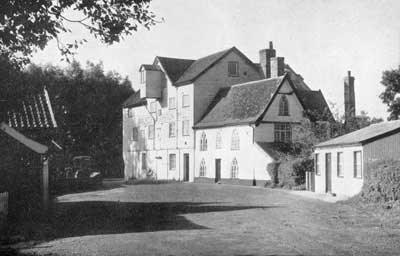 |
|
Walker Marston Mill still
signwritten on the mill c.1954
|
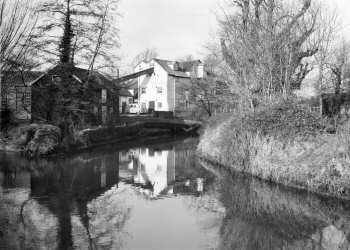 |
|
c.1965
|
|
Under Hovis,
flour milling ceased in 1949 and the mill was converted to a provender
mill, taking over the animal feed business from Earsham
Mill. |
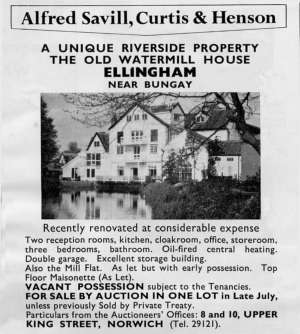 |
|
1970 Auction advert
|
| The result of
the auction was: Lot 1: The Mill House sold to Mr. P.B. Wordley of Norton for £3,050 Lot 2: The Office sold to Mr. P.B. Wordley of Norton for £775 Lot 3: The Warehouse was withdrawn at £2,250 Lot 4: A Small Granary sold to Mr. P.B. Wordley of Norton for £750 Lot 5: Large Barn & Garage sold to Mr. B.C. Hutson of Godmanchester for £1,650 Lot 6: The Mill sold to Mr. B.C. Hutson of Godmanchester for £3,000 |
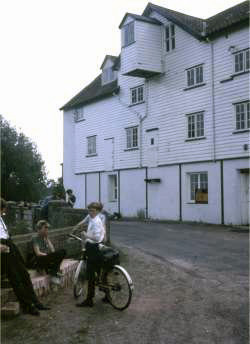 |
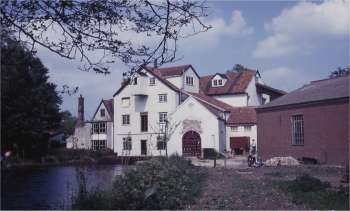 |
|
June 1967
|
June
1967 |
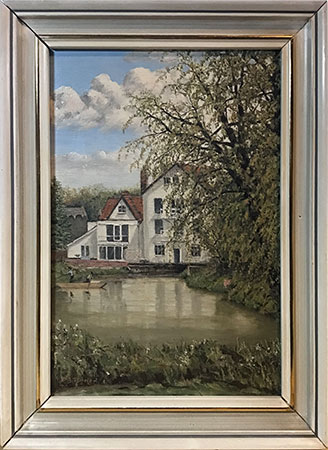 |
|
Painting by C B Taylor - c.1970 |
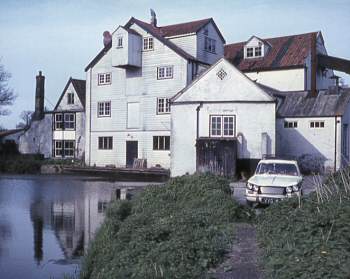 |
c.1975 |
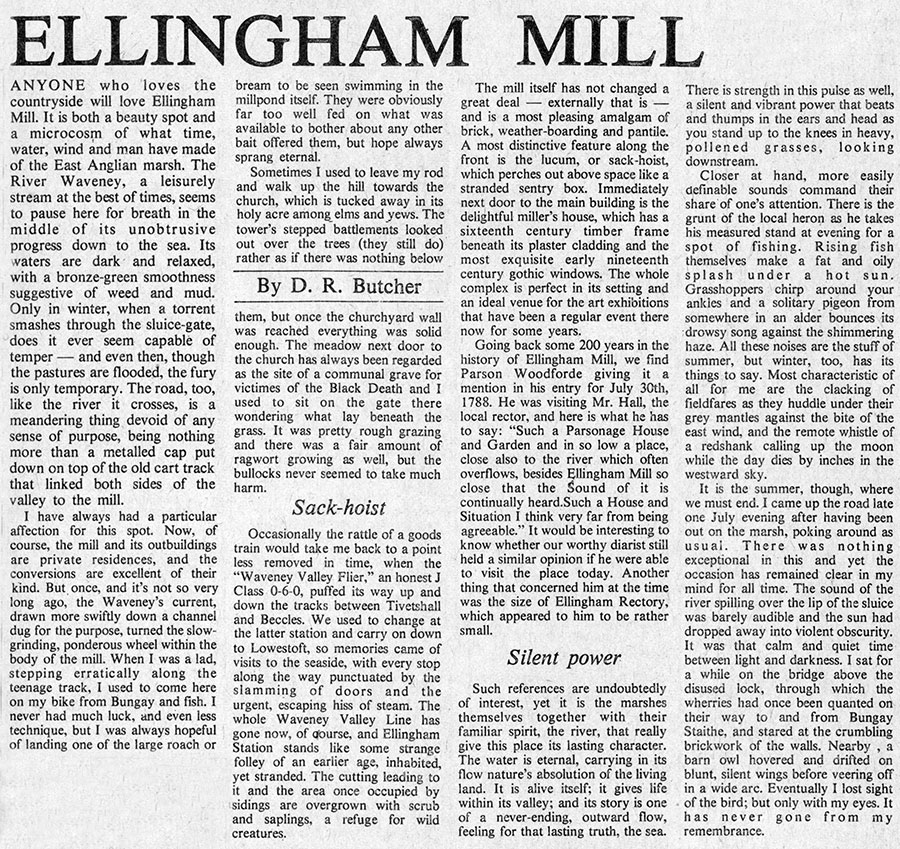 |
|
Eastern Daily Press - 29th July 1978
|
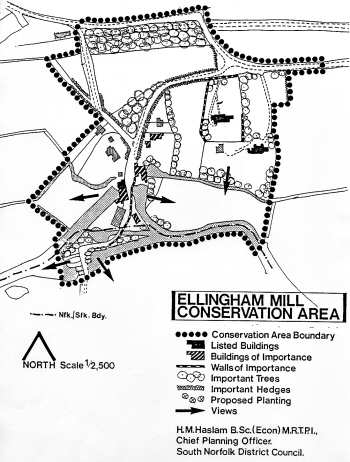 |
|
1979 |
| Several structural changes were made to the mill between 1900 and 1985 including doubling the amount of windows in the front elevation to 16 and inserting a gable into the front elevation and to take the third lucum. |
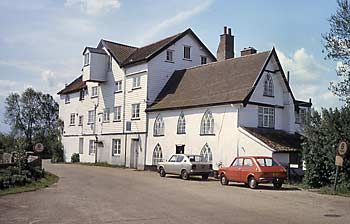 |
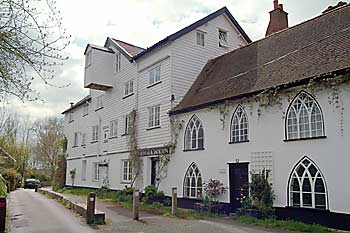 |
|
c.1984
|
11th
April 2004 |
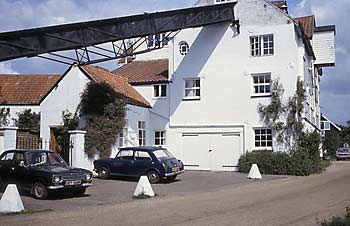 |
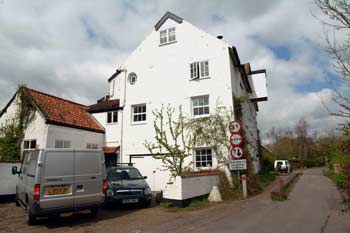 |
|
Elevator still in position c.1984
|
11th
April 2004 |
|
I saw the pictures of Ellingham mill on your website today and lots
of childhood memories came flooding back. My grandparent's lived in one
of the mill cottages at that time and I spent much of my young days fishing
at the front of the mill. |
While researching my husband's family tree I have discovered that his Great Great Great Great Great Grandfather was Lincoln Matchett, the miller in 1772. Lincoln's daughter Frances married John Reynolds and their son and subsequent grandson were named John Lincoln Reynolds, but other than the line of descent down to Ian we know nothing of Lincoln himself. |
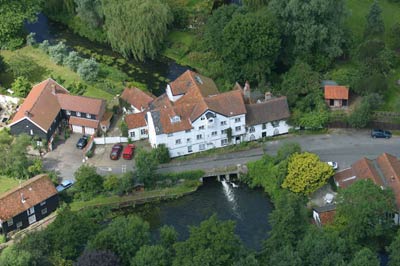 |
24th July 2002 |
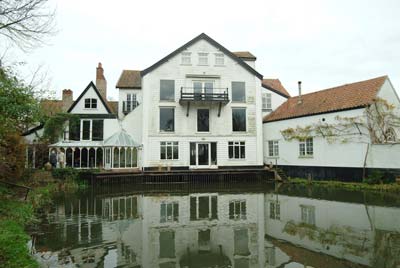 |
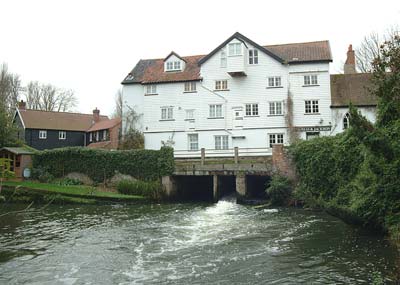 |
|
27th November 2004
|
27th
November 2004 |
I am a descendant of a brother of William David and Arthur Ernest Walker, one-time owners of Ellingham Mill. My mother was born Vera Joyce Walker. |
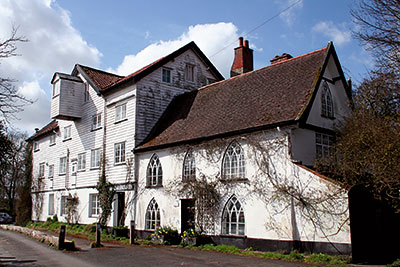 |
15th April 2013 |
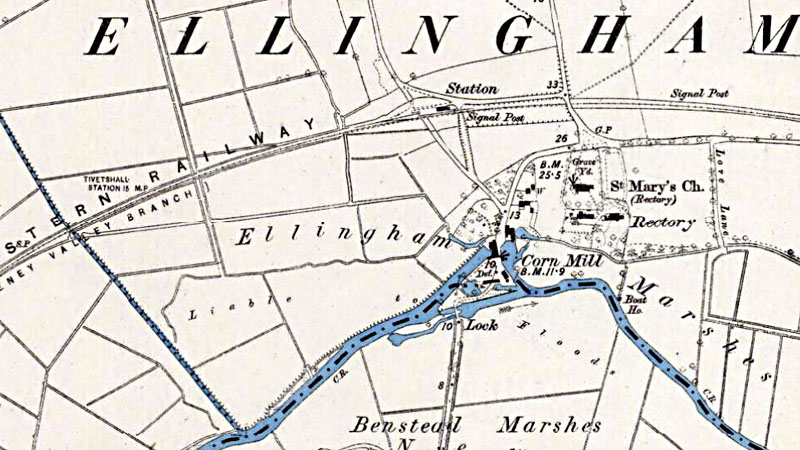 |
O. S. Map 1882-1884 |
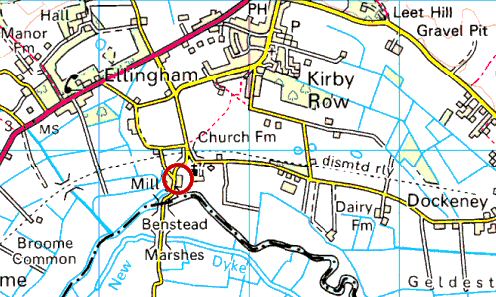 |
O.S. Map 2005 Image reproduced under licence from Ordnance Survey |
| 1444: A crowd
of some 500 persons, mainly from Bungay, gathered and demolished the sluices
of Ellingham Mill. One of the leaders was John de Martlesham of Wainford
Mill 1772: Lincoln Matchett, miller Parson Woodforde's diary 30th July 1788 Faden's map 1797 Norwich Index of Wills 1831: Henry Hannant White's 1836: Robert Burtsal White's 1845: Robert Burtsal
White's 1854: Robert Burtsal - corn miller April 1856: Robert Burtsal died at the age of 52 White's 1864: William Shearing, farmer, miller & merchant (b. 1831) White's 1883: Henry Youngman, miller White's 1890: Henry Youngman, miller, corn and coal merchant, farmer, and assessor of taxes Water mills
Kelly's 1904: Henry Youngman Kelly's 1908: W. D. & A. E. Walker Limited (E. G. Youngman, manager) Ellingham patent roller mills Kelly's 1912: W. D. & A. E. Walker Limited (E. G. Youngman, manager) Ellingham patent roller mills Kelly's 1916: W. D. & A. E. Walker Ltd (E. G. Youngman, manager) Ellingham patent roller mills T N 8 Bungay
1930: Flour milling ceased and the mill became a provender mill Kelly's 1937: W.D. & A. E. Walker Ltd - Roller Mills c.1967: Ceased operation having been last used under the ownership of Vitovis Ltd July 1969: Mill house and mill flats for sale. Talk of filling in the lock Norfolk CC Report 1969: Residential April 1977: Art gallery used by Ellingham Mill Art Society 6th December 1979: Ellingham Mill Conservation Area plan approved having been submitted in March 1977 |
If you have any memories, anecdotes or photos please let us know and we may be able to use them to update the site. By all means telephone 07836 675369 or
|
| Nat Grid Ref TM 36499174 | Copyright © Jonathan Neville 2004 |